Philips Bundle
Who Buys Philips Products?
In the fast-evolving world of health technology, understanding Philips SWOT Analysis is crucial to success. Knowing the Philips target market and customer demographics Philips is key for any company. This is especially true for a company like Royal Philips, which has dramatically shifted its focus over the years.
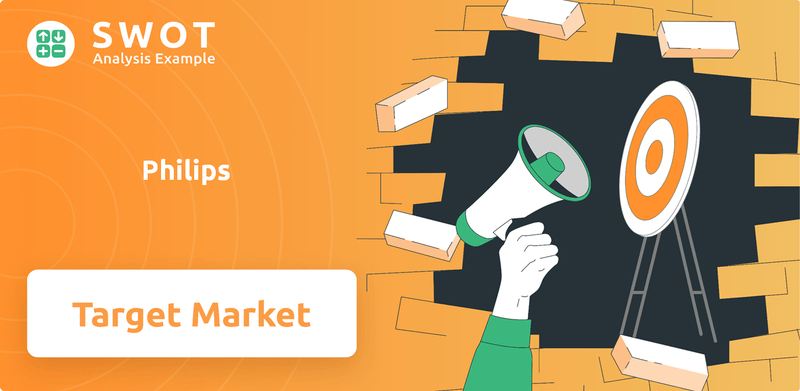
To truly grasp Philips' current standing, we must dissect its Philips company profile and delve into its Philips consumer base. This analysis will explore Philips market segmentation and Philips audience analysis, revealing who are Philips' main customers and how the company strategically positions itself. We'll examine Philips customer demographics by age, Philips target market for healthcare products, and more, to offer a comprehensive view of their customer landscape.
Who Are Philips’s Main Customers?
Understanding the customer demographics and target market of the company involves analyzing its diverse customer segments. The company primarily operates in both Business-to-Consumer (B2C) and Business-to-Business (B2B) markets, with a significant focus on healthcare technology. This dual approach allows the company to serve a wide range of customers, from individual consumers to large healthcare providers.
The company's strategic direction has increasingly emphasized healthcare technology, leading to a greater focus on B2B healthcare providers. The company aims to improve the lives of 2.5 billion people a year by 2025, with a broader goal of 3 billion people annually by 2030 through integrated solutions across the health continuum. This reflects a clear strategic direction towards a health-focused customer base.
For the B2C market, the company offers personal health products, serving individual consumers. This includes products related to personal care and home appliances. The Diagnosis & Treatment segment, which includes diagnostic imaging, ultrasound, and image-guided therapy, accounted for 59% of the company's total sales in 2024, highlighting its significant revenue contribution.
The B2B segment primarily includes hospitals, clinics, and other healthcare providers. The company develops and manufactures medical diagnostic imaging systems, patient monitoring systems, and healthcare informatics for this segment. These professional health solutions cater to the needs of healthcare professionals and their patients within hospital settings and at home.
The B2C segment focuses on individual consumers. This includes products related to personal care, home appliances, and other consumer health products. The company aims to provide innovative solutions that enhance the quality of life for individual consumers through its diverse product offerings.
The company has a global presence, with a significant portion of its sales coming from North America. In 2024, North America comprised a substantial portion of these sales, with 7.7 billion euros. This highlights the importance of the North American market for the company's overall revenue.
- North America: A key market contributing significantly to overall sales.
- Europe: Another important market, though specific sales figures are not provided in the context.
- Developing Countries: The company's focus on improving lives extends to developing countries.
Philips SWOT Analysis
- Complete SWOT Breakdown
- Fully Customizable
- Editable in Excel & Word
- Professional Formatting
- Investor-Ready Format
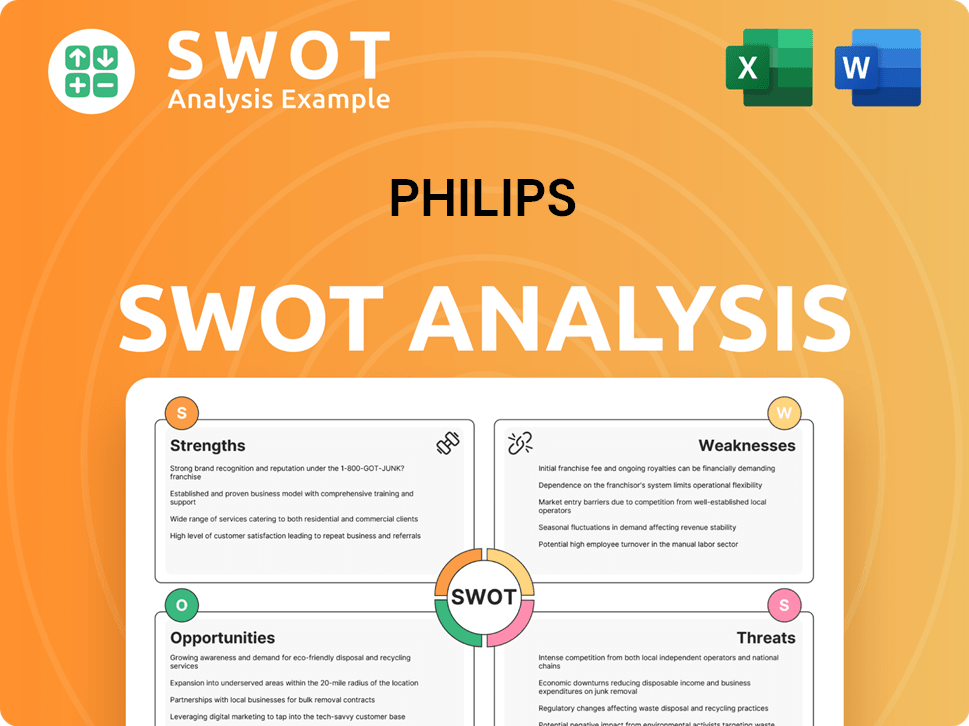
What Do Philips’s Customers Want?
Understanding customer needs and preferences is crucial for the success of any business. For the company, this involves catering to a diverse range of needs across different segments, including both healthcare professionals and individual consumers. The company’s approach is to provide solutions that improve health outcomes, enhance operational efficiency, and offer convenient personal health management.
In the business-to-business (B2B) healthcare sector, the focus is on providing advanced technology that improves patient care and clinical outcomes. This includes addressing critical challenges such as staff shortages and rising healthcare costs. For consumers, the emphasis is on innovative, reliable, and user-friendly personal health products, with a growing emphasis on sustainability.
The company uses a data-driven approach to understand its customers, utilizing feedback and market research to inform product development and personalize marketing campaigns. This customer-centric approach ensures that products meet the evolving needs of its diverse customer base. For further insights into the company's strategic direction, you can explore the Growth Strategy of Philips.
The company's customer needs and preferences are varied, depending on whether they are in the B2B or B2C segment. Healthcare professionals seek advanced technology to improve patient care, while consumers desire innovative and user-friendly personal health products. This is a key aspect of the company's market segmentation strategy.
- B2B Healthcare: Prioritizes advanced technology, improved patient care, enhanced clinical outcomes, and operational efficiency. For example, the adoption of automation and AI is critical in addressing staff shortages, with 92% of healthcare leaders believing this is essential in 2024.
- B2C Consumers: Focuses on innovative, reliable, and user-friendly personal health products. There is also a growing demand for eco-friendly products and sustainable practices.
- Sustainability: The company addresses the demand for eco-friendly products through its EcoDesigned products. In 2024, all new product introductions were 100% EcoDesigned, focusing on energy efficiency, material optimization, and reduced hazardous substances.
- Data-Driven Approach: The company uses customer feedback and market research to influence product development and personalize marketing campaigns.
Philips PESTLE Analysis
- Covers All 6 PESTLE Categories
- No Research Needed – Save Hours of Work
- Built by Experts, Trusted by Consultants
- Instant Download, Ready to Use
- 100% Editable, Fully Customizable
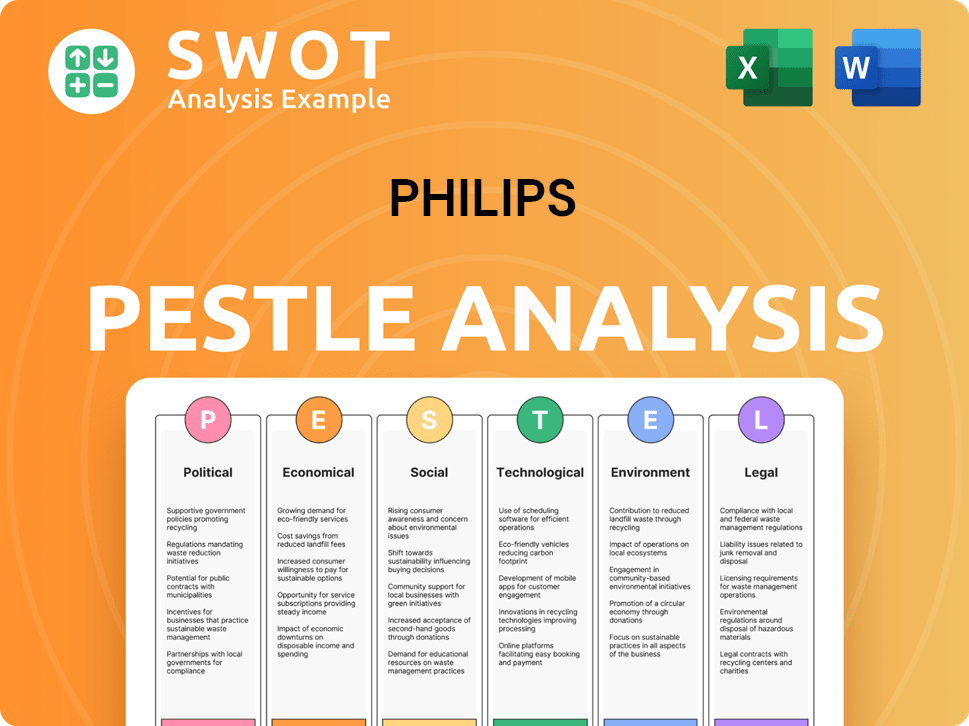
Where does Philips operate?
The geographical market presence of the company is extensive, spanning over 100 countries worldwide. This wide reach allows the company to tap into diverse consumer bases and market opportunities. The company's sales are significantly influenced by its performance in key regions, with North America and Western Europe being major contributors.
North America is consistently a strong market for the company, particularly in the diagnosis and treatment segment. The company strategically adapts its offerings and marketing approaches to suit local markets. This includes adjusting products, branding, and marketing strategies to align with local cultures and consumer behaviors.
The company's global strategy involves a 'local for local' manufacturing approach to mitigate trade impacts and cater to regional demands. The company's commitment to understanding and meeting the needs of its diverse customer base is a key factor in its sustained global presence.
In 2024, North America accounted for 7.7 billion euros in sales within the diagnosis and treatment segment. In Q1 2024, North America had the highest revenue sales, reaching USD 1900.83 million (EUR 1,745 million), with a nominal change of 2% from Q1 2023. This region also leads in the global digital radiography market.
Western Europe is another significant market, contributing approximately USD 928.08 million (EUR 852 million) in revenue. This region showed a 6% growth rate. The company's presence in Western Europe highlights its strong foothold in the European market and its ability to drive sales growth.
The company faced a double-digit decline in sales in China in 2024, which impacted overall comparable sales growth. Despite these challenges, the company is adapting its strategies to address market-specific issues and maintain its global competitiveness.
Despite the challenges in China, the company anticipates overall comparable sales growth of 1%-3% for 2025. This projection indicates the company's resilience and strategic focus on long-term growth. For more insights into the company's marketing approach, you can read about the Marketing Strategy of Philips.
Philips Business Model Canvas
- Complete 9-Block Business Model Canvas
- Effortlessly Communicate Your Business Strategy
- Investor-Ready BMC Format
- 100% Editable and Customizable
- Clear and Structured Layout
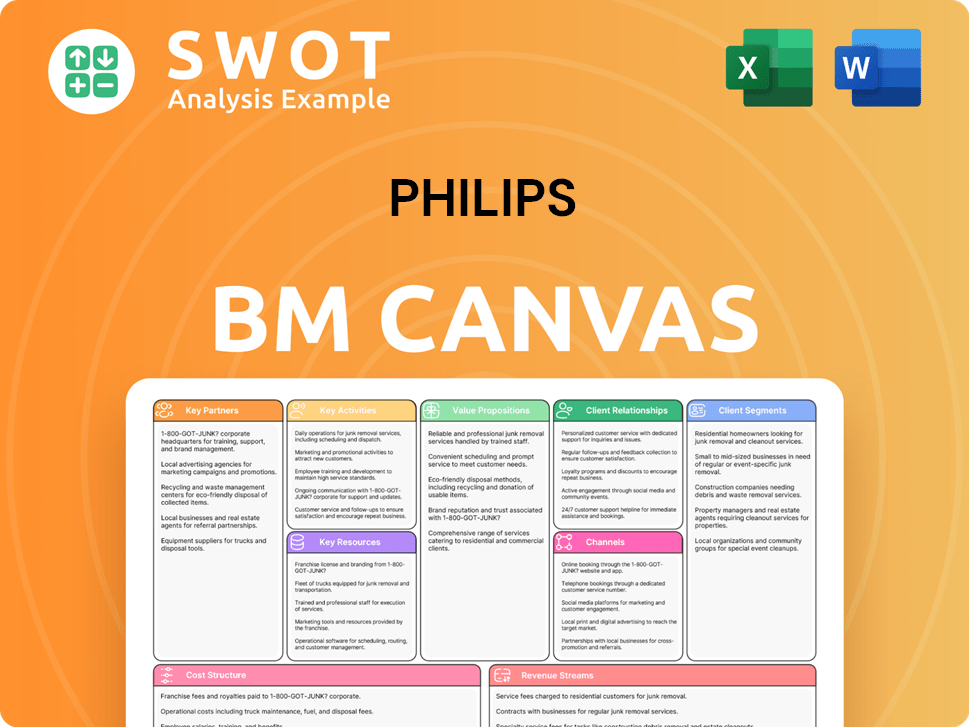
How Does Philips Win & Keep Customers?
The company employs a multi-faceted approach to attract and retain customers. This strategy leverages both traditional and digital marketing channels, strategic partnerships, and a strong emphasis on customer experience and sustainability. The company's commitment to understanding and meeting customer needs is central to its customer acquisition and retention strategies.
A multi-channel marketing strategy is used, encompassing retail stores, distributors, resellers, e-commerce platforms, social media, and online advertising. This ensures maximum visibility and engagement across diverse consumer touchpoints. Digital marketing and e-commerce are crucial for driving online sales and brand awareness, with online sales growing significantly in recent years. Revenue Streams & Business Model of Philips showcases the company's integrated approach.
Customer retention is fostered through a customer-centric approach, prioritizing satisfaction and building long-lasting relationships. The company actively listens to customer feedback, conducts market research, and uses data analytics to understand consumer preferences and tailor products and services. This focus on customer experience and building strong relationships helps maintain customer loyalty.
The company's digital marketing strategy is critical for driving online sales and brand awareness. Search engine optimization (SEO) and social media marketing are key components. Online sales increased by approximately 10% in 2024, demonstrating the effectiveness of their digital efforts.
The company actively engages with consumers on platforms like Instagram, Facebook, and Twitter. They share product updates and health tips to maintain customer interest. The company saw a 15% increase in social media engagement due to its integrated marketing communications (IMC) strategy in 2024.
The company highlights its commitment to sustainability and corporate social responsibility (CSR) in its marketing. This appeals to eco-conscious consumers. The company aims to increase circular revenues to 25% of sales by 2025, demonstrating its commitment to reducing waste and pollution.
Strategic partnerships with healthcare providers are a key element of customer acquisition and retention. These partnerships have led to increased sales in specific segments. Partnerships led to a 6% increase in sales within its connected care segment in 2024.
The company prioritizes customer satisfaction and builds long-lasting relationships. This approach includes actively listening to customer feedback and conducting market research. This customer-centric approach supports customer retention and brand loyalty.
- Focus on understanding consumer preferences.
- Tailoring products and services to meet customer needs.
- Using data analytics to inform decision-making.
- Improving supply chain reliability.
Philips Porter's Five Forces Analysis
- Covers All 5 Competitive Forces in Detail
- Structured for Consultants, Students, and Founders
- 100% Editable in Microsoft Word & Excel
- Instant Digital Download – Use Immediately
- Compatible with Mac & PC – Fully Unlocked
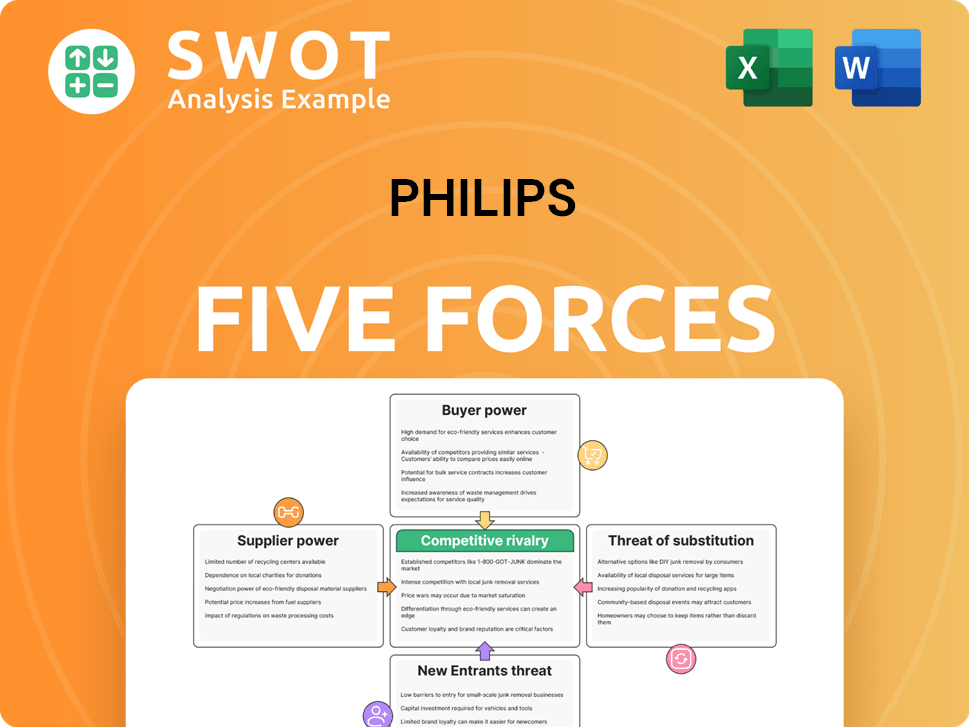
Related Blogs
- What are Mission Vision & Core Values of Philips Company?
- What is Competitive Landscape of Philips Company?
- What is Growth Strategy and Future Prospects of Philips Company?
- How Does Philips Company Work?
- What is Sales and Marketing Strategy of Philips Company?
- What is Brief History of Philips Company?
- Who Owns Philips Company?
Disclaimer
All information, articles, and product details provided on this website are for general informational and educational purposes only. We do not claim any ownership over, nor do we intend to infringe upon, any trademarks, copyrights, logos, brand names, or other intellectual property mentioned or depicted on this site. Such intellectual property remains the property of its respective owners, and any references here are made solely for identification or informational purposes, without implying any affiliation, endorsement, or partnership.
We make no representations or warranties, express or implied, regarding the accuracy, completeness, or suitability of any content or products presented. Nothing on this website should be construed as legal, tax, investment, financial, medical, or other professional advice. In addition, no part of this site—including articles or product references—constitutes a solicitation, recommendation, endorsement, advertisement, or offer to buy or sell any securities, franchises, or other financial instruments, particularly in jurisdictions where such activity would be unlawful.
All content is of a general nature and may not address the specific circumstances of any individual or entity. It is not a substitute for professional advice or services. Any actions you take based on the information provided here are strictly at your own risk. You accept full responsibility for any decisions or outcomes arising from your use of this website and agree to release us from any liability in connection with your use of, or reliance upon, the content or products found herein.